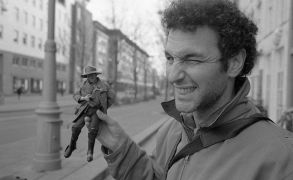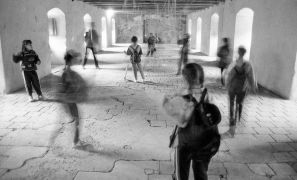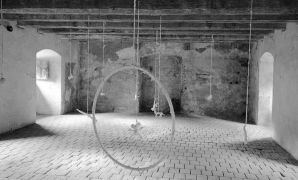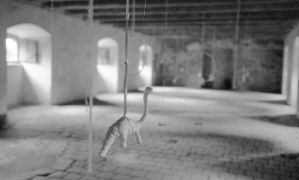„In the Order of Things“ is an installation concerning the ritualizing of ordinary objects in the scheme of the imaginary. The seemingly invisible objects suspended and rapped in rubber bands hanging from the ceiling of the granary, spin and dangle in a moving pattern of transparency and space when pulled by the viewer. The object, whether a brontosaurus or a spoon, a cup, gun or biomorph, disassociate the narrative sequence ordering the objects in an allusive commentary about internalized. Images combine, dissuade and come apart as a visual field. This personalization of memory seen through the eyes of a child mixes fiction with the mundane, the cartoon with the perverse, the historical with the idiosyncratic. Space and location become an invocation to disorientation. The objects covered with latex become weightless and self-contained in place, neither articulation nor competing with the architecture. The images become a mental state, a psychological condition, and then a disappearance. I was inspired by a mistaken conversation about Franz Kafka´s mother. Hence "In the Order of Things in the Kitchen of Late Mrs. K.". This of course relates to the disorder of appearances when considered in relation to the unknown, the absent.
Charlie Citron, 1999 Plasy
Dispersion, Fragmentation and Hypertext
The Fairy-Tales exhibition was a wonderfully peculiar project characterized by a variety of approaches to the question of narrative explored and realized by artists. I think that a process of montage was visible throughout the project as a means of either extrapolation, dispersing, fragmenting or satirizing fictional or appropriated pre-existing stories and myths, whether it was Alice in Wonderland conceived in a sculptural montage which included video, projection, found objects and slipped audio with hypertext, or if it was an absurdist mapping of a dance to the Iliad. The interface between high-tech and low-tech created a symbiosis with the architecture, or a friction denying the probability of the reality of place and the possibility of describing. A story in linear time through visual art. The mind tries to establish logos (thank you Monica), but to talk of identity is a weakness because everything is fiction (thank you Yuri), and one can find identity and diversity in a grain of sand (thank you Alison), and you cannot derive the origin or of myth without creating them (thank you Abdelali), and the abstraction cannot be located whether analogue, digital, or material (thank you Erwin), and memory is always idiosyncratic (thank you Dan), and improvisational montage whether performance or high-tech needs to be inventive and entertaining (thank you Gail and Stephanie), and a common stream running through the center of town can be an adventure, and in wild nature nothing has been done before (thank you Redas), ultimately people is the most important thing, whether it´s children in action or an interface with the community (thank you Michael), and we do virtually project ourselves into space as body and language (thank you Alex), and all material disintegrates including video tape, so what is the meaning of our dependence on technologies to tell a story (thank you Martin), and indeed we need to continue despite all these extrapolation to hone our communication, to maximize poetic reception which is very abstract (thank you Denise), and still remember that the main issue at hand is human development not just through the practical or theoretical rearrangement of image and language, but through a deep humanism and empathy for each other (thank you Milos). The Fairy tales of History is perhaps the most terrifying fact. This has become increasingly evident as hyper image and text in an intercultural stew which accelerates the discontinuity of classical thinking regarding of narrative. In fact, one cannot separate narrative from abstraction, nor can one define the multi-layering of meaning as coherent, without imposing one´s own narrative onto the images. Each artist seemed to be aware that the qualities of dispersion of fragmentation is not a schizophrenia or pathos but a meta-language resounding with qualities of their persona. Even when we are locked inside an alphabet, it is never entirely our own. Language is always inside language. The romantic, rigorous, and historical setting of a baroque monastery, the meaning of its space and walls. Its delicate acoustic and oppressive monumentality, only served to heighten the struggle within us to scatter stereotypes of fairy tales and to reinvent the conventions of narration to include simultaneity, repetition, absurdist juxtaposition, and serious cultural satire. Perhaps some of the questions lie in our descriptive sensitivity, in our combinations of linear thinking, circular thinking, pluralism, and the acceleration of information. When the mind is moving very fast, it can be necessary to move slowly.
Charlie Citron, 1999 Plasy
Charlie Citron (1958) is a sculptor, photographer and curator. He was born in New York, studied art history in the U.S. (1982 BA Art/Art History State University of New York at Binghamton) and attended the Rijksakademie in Amsterdam (1988 Fellow Rijksakademie van beeldende kunsten, Sculpture Department). He has participated in many international exhibitions in New York, Europe and Asia, ranging from museums, galleries, residencies, on-site events and community projects. Charlie Citron lives in Amsterdam and works with rubber bands, found objects, photography, wax and narratives.




